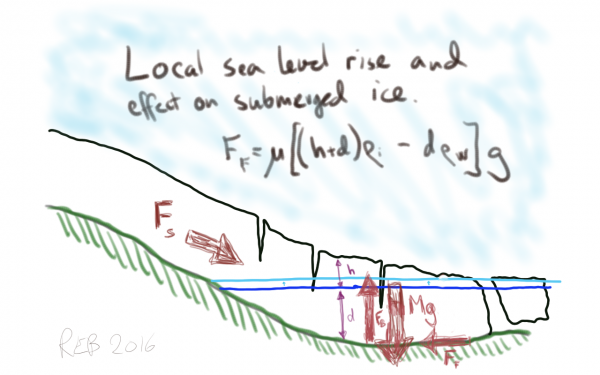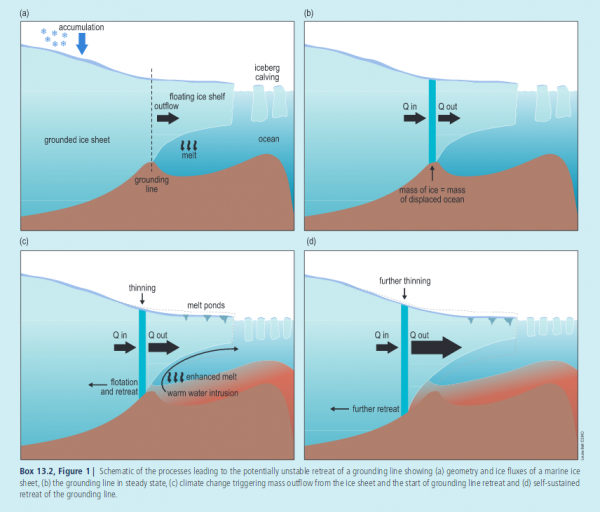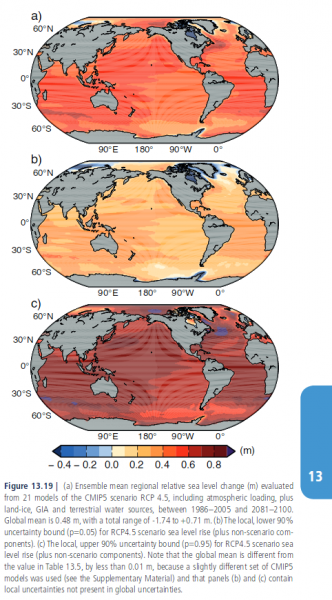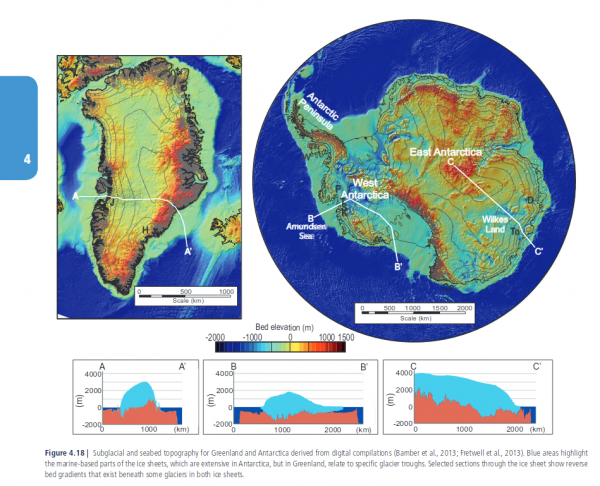Can a rising sea level can act as a boost for glaciers calving into the sea and trigger a surge of ice into the oceans? I finally got round to watch the documentary Chasing Ice over the Christmas and New Year’s break, and it made a big impression. I also was left with this question after watching it.
There is a connection between the unfolding events in the polar regions and our lives. The sea level may rise in jumps and spurts as a consequence of events where ice masses surge into the oceans. A sea level rise will affect a number of megacities, low lying parts of Florida, and properties along the coast of Norway: Storm surges will cause larger inundation and more damage.
The question whether there are mechanisms that may speed up the sea level rise is therefore relevant for many people. One plausible scenario can be sketched as a balance of forces (graphics below).
At the moment, this is just a speculation from my side. I don’t know if it’s even plausible. My simple back-of-the-envelope description provides a naive picture, and it is possible that any such effect is very marginal compared to warm water intrusion. Or that the sea level rise is too small to have any noticeable effect. But I don’t know the answer yet.
There are some fruitful ways to satisfy my curiosity, and the first thing should be to search reliable bodies of knowledge. I want to be able to trace the information back to their roots, which means that sources are based on transparency and can be replicated by others.
There are some great resources for finding the best information on ice and climate change: The Arctic Monitoring and Assessment Programme (AMAP) Snow Water Ice and Permafrost in the Arctic (SWIPA; AMAP, 2011) and the recent IPCC assessment report (AR5) chapters four and thirteen. Both these reports provide a review and assessment of the scientific literature relevant to my question. They also include proper references.
In none of these was I able to find an account of any feedback effect from rising sea levels on the flow of the ice sheets and glaciers.
I have found that there exist reports about effects which intrusion of warm seawater may have on submerged ice (eg Holland et al. 2008). There is also a number of studies about the contribution of glacier calving to the global sea level (eg Meier et al. 2007).
There was some information that almost seemed to be relevant for my question was the following passages from AR5 [13.4.3.1 “Surface Mass Balance Change”, p. 1167]:
The main feedbacks between climate and the ice sheet arise from changes in ice elevation, atmospheric and ocean circulation, and sea-ice distribution.
But ice elevation is not the same as sea level, and is relevant for glaciers mass-balance connected to snow accumulation and melting.
Another section from AR5 discusses the marine ice sheet instability (MISI), which is relevant to my question [13.4.4.2 “Dynamical Change”, p. 1174]:
The MISI is based on a number of studies that indicated the theoretical existence of the instability … The most fundamental derivation, that is, starting from a first-principle ice equation, states that in one-dimensional ice flow the grounding line between grounded ice sheet and floating ice shelf cannot be stable on a landward sloping bed.
The AR5 also discusses a feedback effect concerning the grounding line and ice thickness and the consequence for the sea level (also see graphic below), but does not include the effect a sea level rise may have [FAQ 13.2, p. 1177]:
On bedrock that slopes downward towards the ice-sheet interior, this creates a vicious cycle of increased outflow, causing ice at the grounding line to thin and go afloat. The grounding line then retreats down slope into thicker ice that, in turn, drives further increases in outflow. This feedback could potentially result in the rapid loss of parts of the ice sheet, as grounding lines retreat along troughs and basins that deepen towards the ice sheet’s interior.
I also searched with Google scholar, without finding any answer. There may of course be studies about the effect that a sea level rise may have on the glacier calving that I have missed.
A reason why the scenario that I sketched out may be less important is that the sea level rise is expected to be smaller near the poles due to Earth’s redistribution of mass and the consequences for gravitational forces (see graphics below). But this is also a speculation as far as I know. What if the current situation is a result of a fine balance of forces over time that includes the buoyancy associated with past estate levels?
Any triggering effect that a sea level rise may have on the submerged ice sheets and glaciers buttressed by the ocean floor depends on the depth of the ocean floor and the thickness of the ice.
We can get a rough estimate of the reduction of the weight responsible for the friction: δF=ρgδh. Every cm sea rise corresponds to a reduction due to increased buoyancy for ice resting on the ocean floor of 1000kg/m3 x 9.8m/(kg s2) x 0.01 (m)= 98 N/m2.
The change in the net sum of forces caused by a sea level rise is expected to have little effect in most regions, except where the gravitational force of the ice sheet is close to being balanced out by the buoyancy.
An additional surge of ice into the ocean will further increase the sea level, which subsequently may affect the buttressing effect of the ice itself. Is there a triggering point beyond which a feedback process is put into action that will accelerate the disintegration of some of the ice sheets?
According to AR5 (graphics below), there may be some regions where a sensitivity to a sea level is not too unlikely, although this needs to be investigated in more details.
I cannot recall ever having seen or heard any discussion about the possible effect a rising sea level may have on the ice sheet dynamics. Hence, is there anybody who know of published work that is relevant to my question?
Progress happens through scientific discussions, calculations, formulation of hypotheses, and the testing of these, and this is our best bet to get closer to a true answer. And of course, others need to reproduce the same results independently. Convincing answers then result in a consensus.
Happy new year!
References
- D.M. Holland, R.H. Thomas, B. de Young, M.H. Ribergaard, and B. Lyberth, "Acceleration of Jakobshavn Isbræ triggered by warm subsurface ocean waters", Nature Geoscience, vol. 1, pp. 659-664, 2008. http://dx.doi.org/10.1038/ngeo316
- M.F. Meier, M.B. Dyurgerov, U.K. Rick, S. O'Neel, W.T. Pfeffer, R.S. Anderson, S.P. Anderson, and A.F. Glazovsky, "Glaciers Dominate Eustatic Sea-Level Rise in the 21st Century", Science, vol. 317, pp. 1064-1067, 2007. http://dx.doi.org/10.1126/science.1143906




Hi Rasmus, and happy new year!
the idea of sea-level influence on ice sheet dynamics is not new, but as you indicate, references are not easily googleable. this is most likely due to the minor importance of the effect, such that it doesn’t make it into the titles.
you may find this reference a good starting point:
Schoof, C. (2007), Ice sheet grounding line dynamics: Steady states, stability, and hysteresis, J. Geophys. Res., 112,F03S28, doi:10.1029/2006JF000664.
[Response: Thanks, Thomas! -rasmus]
Big Waves Bust Up Sea Ice, May Be Playing Role in Melt
http://www.climatecentral.org/news/big-waves-sea-ice-climate-17490
As big waves can exert enough leverage to break the ice, likely rising tides can, eh?
Hmmm. If big waves can do significant damage to the ice (grounded or sea), it seems there should also be a feedback between increasing fetch as ice coverage declines and both breakup of sea ice and damage to grounded ice/ ice shelves blocking/ slowing the flow of upstream ice.
P.S.: Unforced Variations: June 2015 « RealClimate
https://www.realclimate.org/index.php/archives/2015/06/unforced…/comment-page-6/
Jun 1, 2015 – That’s what I called the “Ice Cube Catastrophe” scenario — a sudden rumble, the ice cap becomes crushed ice and rushes to the sea….
Thanks for this article. Can one use the tidal swells and associated quickening and lagging of ice flow recorded on some glaciers to better quantify the effect ?
So, the papers that you are looking for are all from Natalya Gomez (see links below). She has shown, in an ice sheet model with gravitationally self-consistent sea level, there is actually a sea level fall at the grounding line, which acts to stabilize against the marine ice sheet instability. Thus, the feedback goes in the opposite direction of what you have sketched here.
http://www.nature.com/ngeo/journal/v3/n12/abs/ngeo1012.html
http://onlinelibrary.wiley.com/doi/10.1029/2011JF002128/full
[Response: Not at the opposite though. – gavin]
Tides will flex the shelves. Does ice shelf plasticity change with slight warming?
Some tide changes – in Antarctica commonly stated at about 30cm… however I read: ” Even though Antarctic ice shelves can be up to about 1.6 kilometers (1 mile) thick in places, tides can lift these shelves as much as 4.5 meters (about 15 feet).”
Other sources closer to 1 meter.
http://earthobservatory.nasa.gov/IOTD/view.php?id=6110
http://tides.mobilegeographics.com/locations/5412.html
http://researchnews.osu.edu/archive/icetide.htm
On comment to #6, Gavin, could you elaborate? I’ve downloaded Gomez, et al.
Is this a re-consideration of James Hansen’s concerns?
Yes, it is the case that a far-field change in sea level will cause this sort of speed up (this idea goes back to Thomas and Bentley, 1978 in Quaternary Research and perhaps earlier). As one of the above comments suggests, Schoof (2007) shows that, under certain conditions, ice flux through the grounding line goes like b(x_g)^4.75 where b(x_g) is the depth of the bed below sea level at the grounding line. Thus, for every 1% increase in local sea level, there is a ~5% increase in ice flux through the grounding line (though this may be higher if the bed is slippery near the grounding line, see Tsai et al. 2015).
But then, of course, as you lose mass from the glacier, you need to account for the change in sea level locally, which can be an order of magnitude greater than average changes in far-field sea level (Mitrovica 2009). Hence, my earlier comment.
I think the story here is that the back-of-the-envelope calculation is perhaps missing a few potentially important things, such that it is not easy to figure out where sea level changes may have a significant influence on ice flow without also taking into account friction at the bed (which has non-obvious spatial variations – see Sergienko & Hindmarsh 2013) and spatial variations in ice shelf buttressing. These other factors are known to be quite influential in modulating ice sheet change. More recent studies (e.g. Gomez et al. 2015 in Nature Comm.) have modeled future changes in sea level in a self-consistent fashion (i.e. taking into account the spatial variations in sea level change), though I agree that more studies need to follow this lead and perhaps do the coupled problem of Greenland and Antarctica.
Absolutely there is a connection between sea level rise and feedbacks that tend to drive ice more rapidly into the sea, which then further raises sea level and the further feedback into driving more ice into the sea. But it is not any sort of runaway process; the feedback loop as just mentioned gets less strong with each loop of the cycle, if you think of it in terms of a cycle. Take as many of these feedback loops as you like, and the feedback here is not strong for the amount of sea level rise taking place on the century timescale. If we consider a meter of sea level rise (pretty much a middling expectation for the next century), how much ice can that float? Around 1.1 or 1.2 m, depending on the seawater or fjord water density and ice density. That gives a rough concept of what we’re talking about– a meter versus, for a typical number, 100 m or several hundred meters of ice thickness flowing into calving environments. So for sure it is a feedback and is a positive feedback loop; sea level rise definitely has the effect of lowering basal resisting shear stresses, and a meter of sea level rise will float ice in cases where the ice initially is barely grounded. But this is not a large feedback compared to the magnitudes of some other important ones. Cases where it starts to become a very important feedback are when you have 10 or 20 m of sea level rise, which is not going to happen any time really soon. So…. it is a very small factor for the coming century, although with a few rare glaciers there is a notable effect. Overall…. unimportant compared to everything else.
> how much ice can that float?
Don’t you expect to suck more (warmer) water in under the ice as it’s lifted up, and squirt more (melted) water out as it’s lowered back down that meter? So enhancing bottom melting of the ice overburden, while penetrating up into any cracks caused by surface meltwater coming down through it
For anyone who enjoys lectures by the Penn State glaciologist Richard Alley, he talked about some of this (which could be called the “woo” effect) in the latter part of a lecture at Stanford back in 2012. He discussed the forcing effects of SLR on marine-based ice sheets with terrain:
https://www.youtube.com/watch?v=o4oMsfa_30Q#t=36m35s
He discusses many of the points made in the work by Schoof. As others noted, Gomez, Mitrovica et al have modeled local sea level fall as ice sheets melt as a “partial negative” feedback.
As AR says in 6 and 10, at least locally (which I think is anywhere up to roughly 2000KM from the site of the iceloss), the feedback is negative, because the missing ice can’t gravitationally attract seawater. So at least Greenland melt won’t trigger sea level rise in Greenland, but Antarctic melt will raise Greenland sea levels, and Greenland melt will trigger Antarctic sea level rise.
Thanks for the youtube link. I had forgotten the bit about a jump in grounding line off a local peak on an otherwise level bed. Then i add in the big hole behind Thwaites and recall that every drop of melt off Greenland is amplified down under. Nudging Thwaites grounding line to the big jump to Transantarctic Mountains on a possible timescale of decades sounds uncomfortably possible.
I wonder if next IPCC report will say 3m SLR by 2100 for high end …
@AR,
Regarding tribology at bed and buttressing, surely these are stationary neither in space nor time, so forecasts are best done with some kind of averaged field effect, understanding that the extreme value statistics are not likely to be accurately characterized by a less-than-Cauchy or less-than-t distribution.
What are the field campaigns like? Is there instrumentation in place on some and preferably several glaciers in the field which can report the series of movements at these points? Can they also concurrently report local mass density of ice?
Rasmus, this is an issue we’ve discussed quite a few times over the years with the ice group here at PIK. It is part of an ongoing grant proposal. Not easy to implement this feedback in models.
I would think just the break up of the Larsen sites alone would be ample empirical evidence as to it happening. For mechanism tho….lot of variables including seafloor and gradient of the ice field plus accumulation levels. Difficult modeling as each glacier/ocean interface would be different. I know I was shocked at the scope of the ice field feeding the Muir Glacier and the evidences of “pulses” of a large magnitude within historical times.
Macdoc @18.
I don’t think Larsen is evidence for SLR induced retreat. Ten to twenty centimeters of SLR will have the same effect on the grounding line as one to two meters of ice thickness reduction. I think we are seeing thickness changes on some these shelves of meters per year, which is orders of magnitude more important than recent SLR. Also many marine glaciers in Alaska have a long cycle of advance followed by rapid retreat, with the Columbia having recently entered the retreat phase, and the Hubbard currently in an advancing phase. If these ice shelves have similar natural cycles, the period is likely to be many thousands of years. But, we know melting due to the advection of warm seawater is the primary ice thinning agent in many of these cases. So the biggest effect is probably due to changes in ocean currents and temperatures.